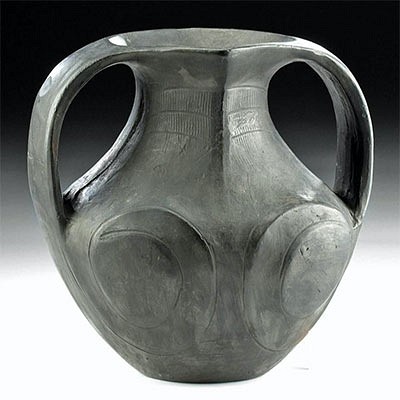19th C. Spanish Colonial Mexican Tin Retablos (2)
Lot 136a
About Seller
Artemis Fine Arts
686 S Taylor Ave, Ste 106
Louisville, CO 80027
United States
Selling antiquities, ancient and ethnographic art online since 1993, Artemis Gallery specializes in Classical Antiquities (Egyptian, Greek, Roman, Near Eastern), Asian, Pre-Columbian, African / Tribal / Oceanographic art. Our extensive inventory includes pottery, stone, metal, wood, glass and textil...Read more
Categories
Estimate:
$600 - $900
Absentee vs Live bid
Two ways to bid:
- Leave a max absentee bid and the platform will bid on your behalf up to your maximum bid during the live auction.
- Bid live during the auction and your bids will be submitted real-time to the auctioneer.
Bid Increments
| Price | Bid Increment |
|---|---|
| $0 | $25 |
| $300 | $50 |
| $1,000 | $100 |
| $2,000 | $250 |
| $5,000 | $500 |
| $10,000 | $1,000 |
| $20,000 | $2,500 |
| $50,000 | $5,000 |
| $100,000 | $10,000 |
| $200,000 | $20,000 |
About Auction
By Artemis Fine Arts
Dec 16, 2021
Set Reminder
2021-12-16 10:00:00
2021-12-16 10:00:00
America/New_York
Bidsquare
Bidsquare : VARIETY SALE | Antiquities & Ethnographic Art
https://www.bidsquare.com/auctions/artemis-gallery/variety-sale-antiquities-ethnographic-art-8026
Featuring classical antiquities, ancient and ethnographic art from cultures encompassing the globe. Egyptian, Greek, Roman, Etruscan, Near Eastern, Asian, Pre-Columbian, Native American, African / Tribal, Oceanic, Spanish Colonial, Russian, Fossils, Fine Art, more! Artemis Fine Arts info@artemisgallery.com
Featuring classical antiquities, ancient and ethnographic art from cultures encompassing the globe. Egyptian, Greek, Roman, Etruscan, Near Eastern, Asian, Pre-Columbian, Native American, African / Tribal, Oceanic, Spanish Colonial, Russian, Fossils, Fine Art, more! Artemis Fine Arts info@artemisgallery.com
- Lot Description
Latin America, Mexico, Spanish Colonial Period, ca. 19th century CE. This is a finely painted pair of Spanish Colonial style retablos on heavy gauge tin depicting religious scenes of saints and Christ. The larger is of the Virgin Mary and Christ Child, a composition that is often referred to as N.S. Refugio de Pecadores (Our Lady, Refuge of Sinners); the Virgin wears a golden crown and supports a crowned Christ Child whose nude body is covered by a transparent robe. She wears a dark blue cape that is initialed with her ciphers. Christ rests his right hand on her right arm and grips her right thumb with his left hand. The touching scene is framed by a wreath of red roses as they float upon heavenly clouds. The other retablo depicts St. Joseph in a green robe and a yellow cloak as he holds the Christ Child, who is draped in red. The Child leans on Joseph's shoulder, and both their heads are surrounded by golden beams of light or a hallo. Size (Mary retablo): 14" L x 10" W (35.6 cm x 25.4 cm); (Saint Joseph): 9.35" L x 6.5" W (23.7 cm x 16.5 cm)
The cult of Joseph originated during the time of Luther when the Catholic Church was seeking out new heroes to meet the needs of the Counter Reformation. Prior to this time, Joseph was somewhat ignored. The Carmelite Order, under the direction of St. Theresa, rejuvenated the image of St. Joseph. Instead of being portrayed as an elderly man who watched over Mary, he grew to be depicted as a virile man in the prime of his life, full of youth and strength, yet portrayed as a gentle man of tenderness as we see in this example.
In 1719, a Jesuit missionary brought a version of a painting originally created for an altar formerly at Frascati, Italy, in the style of Guido or Salvator Rosa, to the city of Zacatecas in Mexico. The painting inspired the locals to adopt N.S., Refugio de Pecadores as their patron, and the composition of this retablo was modeled upon that painting's composition. Renditions of the original Italian painting were among the most favored in retablo art. Icons like these were placed above household altars to venerate the saints. The translation of the word retablo literally means "behind the altar."
Provenance: ex-Dr. David Harner collection, Arkansas, USA, 1950s-1960s
All items legal to buy/sell under U.S. Statute covering cultural patrimony Code 2600, CHAPTER 14, and are guaranteed to be as described or your money back.
A Certificate of Authenticity will accompany all winning bids.
PLEASE NOTE: Due to recent increases of shipments being seized by Australian & German customs (even for items with pre-UNESCO provenance), we will no longer ship most antiquities and ancient Chinese art to Australia & Germany. For categories of items that are acceptable to ship to Australia or Germany, please contact us directly or work with your local customs brokerage firm.
Display stands not described as included/custom in the item description are for photography purposes only and will not be included with the item upon shipping.
#161365The Joseph retablo has losses and flaking to painted pigments and details of the child and Joseph's body are faint and indiscernible. Both retablos have surface abrasions, chipping, and fading to pigments. Finer details are not discernable. Joseph's face is clear enough to discern the saint's expression, but Christ is faint. Stable fissure along lover edge of Joseph retablo, and corners are pierced for suspension, with a cord through the top. Tearing and folding to Virgin Mary's retablo, and losses to pigments. Surface abrasions and fading to pigments. Finer details are not discernable. Corners are pierced for suspension and has a cord through the top. Nice patina on both.Condition
- Shipping Info
-
All shipping is handled in-house for your convenience. Your invoice from Artemis Gallery will include shipping calculation instructions. If in doubt, please inquire BEFORE bidding for estimated shipping costs for individual items.
-
- Buyer's Premium



 EUR
EUR CAD
CAD AUD
AUD GBP
GBP MXN
MXN HKD
HKD CNY
CNY MYR
MYR SEK
SEK SGD
SGD CHF
CHF THB
THB














